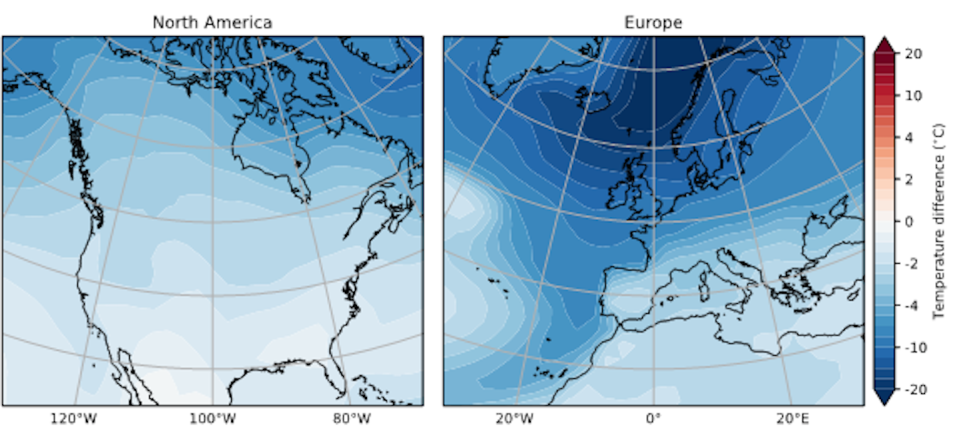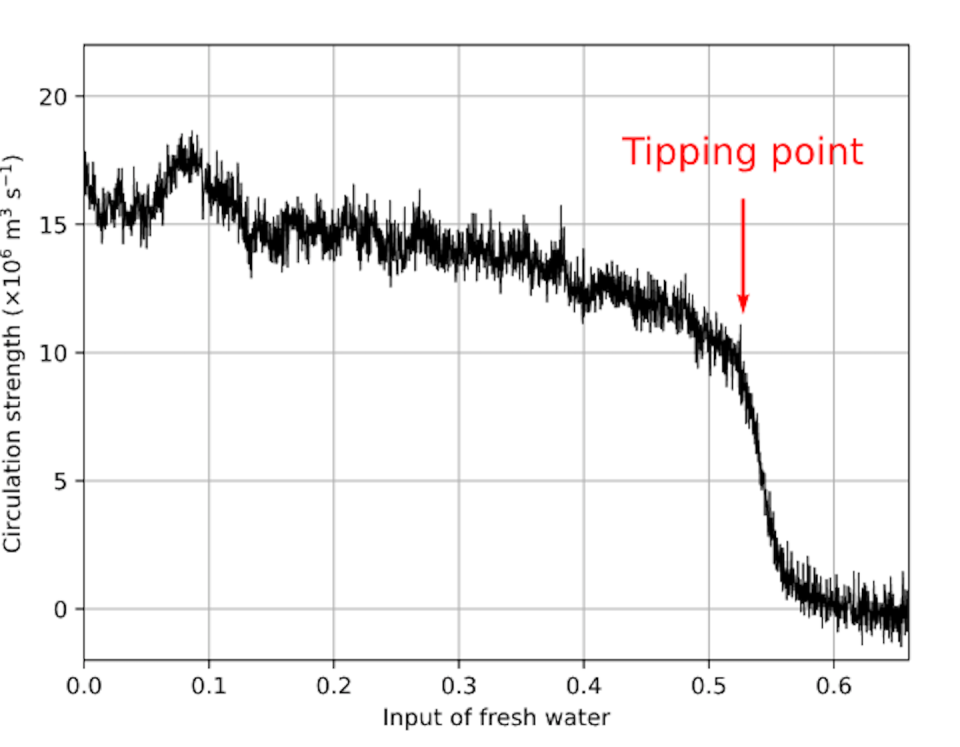Super storms, abrupt climate shifts and New York City frozen in ice. For example, the blockbuster Hollywood film “The Day After Tomorrow” depicted an abrupt cessation of the circulation of the Atlantic Ocean and its catastrophic consequences.
Although Hollywood’s vision was exaggerated, the 2004 film raised a serious question: If global warming halts the Atlantic Meridional Overturning Circulation, which is crucial for transporting heat from the tropics to northern latitudes, how abruptly and would climate changes be serious? ?
Twenty years after the film’s release, we know much more about the circulation of the Atlantic Ocean. Instruments deployed in the ocean starting in 2004 show that Atlantic Ocean circulation has slowed noticeably over the past two decades, possibly to its weakest state in almost a millennium. Studies also suggest that the circulation has reached a dangerous tipping point in the past, sending it into a steep, unstoppable decline, and that this tipping point could be reached again as the planet warms and glaciers and ice caps melt.
In a new study using the latest generation of Earth-based climate models, we simulated the flow of fresh water until the ocean circulation reached that tipping point.
The results showed that within a century of reaching the tipping point, the circulatory system could come to a complete standstill, and that it is moving in that direction. If that were to happen, average temperatures in North America, parts of Asia and Europe would drop by several degrees, and people around the world would see severe and cascading impacts.
We have also discovered a physics-based early warning signal that could alert the world when the Atlantic Ocean circulation is nearing its tipping point.
The conveyor belt of the ocean
Ocean currents are driven by wind, tides and differences in water density.
In the circulation of the Atlantic Ocean, the relatively warm and salty surface water near the equator flows towards Greenland. During its journey it crosses the Caribbean Sea, loops in the Gulf of Mexico and then flows along the US east coast before crossing the Atlantic Ocean.

This current, also called the Gulf Stream, brings heat to Europe. As it flows north and cools, the body of water becomes heavier. By the time it reaches Greenland, it begins to sink and flow south. The sinking of water off Greenland draws water from elsewhere in the Atlantic Ocean and the cycle repeats itself, like a conveyor belt.
Too much freshwater from melting glaciers and the Greenland ice sheet can dilute the salinity of the water, preventing it from sinking, and weakening the ocean’s conveyor belt. A weaker conveyor belt transports less heat north and also allows less heavy water to reach Greenland, further weakening the strength of the conveyor belt. Once it reaches the tipping point, it quickly shuts down.
What happens to the climate at the tipping point?
The existence of a tipping point was first noted in an oversimplified model of the Atlantic Ocean circulation in the early 1960s. Today’s more detailed climate models indicate a continued slowdown in the power of the conveyor belt under the influence of climate change. However, an abrupt cessation of the Atlantic Ocean circulation seemed to be absent in these climate models.
This is where our research comes in handy. We conducted an experiment with a detailed climate model to find the tipping point for an abrupt standstill by slowly increasing the supply of fresh water.
We discovered that once the tipping point is reached, the conveyor belt stops within 100 years. Heat transport towards the north is greatly reduced, leading to abrupt climate shifts.
The result: dangerous cold in the north
Regions affected by the Gulf Stream receive substantially less heat when circulation stops. This cools the North American and European continents by a few degrees.
The European climate is much more influenced by the Gulf Stream than other regions. In our experiment, this meant that parts of the continent were warming by more than 3 degrees Celsius per decade – much faster than the current global warming of about 0.2 degrees Celsius per decade. We found that parts of Norway would experience temperature drops of more than 20 degrees Celsius. On the other hand, regions in the Southern Hemisphere would become a few degrees warmer.


These temperature changes develop over a period of about 100 years. That may seem long, but on typical climate timescales it is abrupt.
Shutting down the assembly line would also impact sea levels and precipitation patterns, potentially pushing other ecosystems closer to their tipping points. For example, the Amazon rainforest is vulnerable to declining precipitation. If the forest ecosystem were to change to grassland, the transition would release carbon into the atmosphere and result in the loss of a valuable carbon store, further accelerating climate change.
The Atlantic circulation has slowed considerably in the distant past. During ice ages, when the ice sheets covering large parts of the planet were melting, the influx of fresh water slowed the Atlantic circulation, causing massive climate fluctuations.
When will we see this tipping point?
The big question – when will the Atlantic circulation reach a tipping point – remains unanswered. Observations do not go back far enough to give a clear result. Although a recent study suggested that the conveyor belt is rapidly approaching its tipping point, possibly within a few years, these statistical analyzes are based on several assumptions that introduce uncertainty.
Instead, we were able to develop a physics-based and observable early warning signal regarding salt transport at the southern edge of the Atlantic Ocean. Once a threshold is reached, the tipping point is likely to follow within one to four decades.


The climate impacts from our study underline the severity of such an abrupt collapse of the assembly line. The changes in temperature, sea level and precipitation will have serious consequences for society, and climate shifts are unstoppable on human time scales.
It may seem counterintuitive to worry about extreme cold as the planet warms, but if the main circulation in the Atlantic Ocean is shut down because too much meltwater flows in, that’s the risk.
This article is republished from The Conversation, an independent nonprofit organization providing facts and trusted analysis to help you understand our complex world. It was written by: René van Westen, University of Utrecht; Henk A. Dijkstra, University of Utrechtand Michaël Kliphuis, University of Utrecht
Read more:
René van Westen receives funding from the European Research Council (ERC-AdG project 101055096, TAOC).
Henk A. Dijkstra receives funding from the European Research Council (ERC-AdG project 101055096, TAOC, PI: Dijkstra).
Michael Kliphuis does not work for, consult with, own shares in, or receive funding from any company or organization that would benefit from this article, and has disclosed no relevant affiliations beyond his academic appointment.